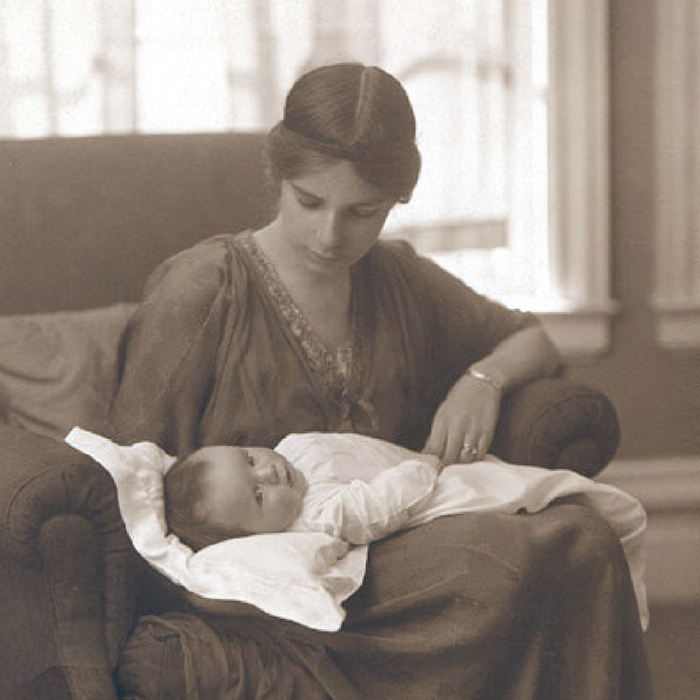
An underrecognized historical figure, Dorothy Tiffany Burlingham (1891–1979) studied the impact of congenital blindness on the psychology of young children (1). If you’re wondering about any connection to the Tiffany, you are correct; she is part of that very famous family. It was her grandfather, Charles Lewis Tiffany (1812–1902), who founded Tiffany & Co – the luxury retailer with particular expertise in diamonds and sterling silver, including the iconic “Tiffany setting” engagement ring. Her father, Louis Comfort Tiffany (1848–1933), was a leading artist, especially with glass. He patented an iridescent “Favrile” glass that appears to change color when viewed from different angles.
Despite her great wealth and social standing, Burlingham was deeply troubled; she had what could be described as a “midlife crisis” at the age of 30 in 1921. She left her husband, surgeon Robert Burlingham (1887-1938), and sailed for Europe with their four children seeking psychoanalysis. There, she met child psychoanalyst Anna Freud (1895-1982) – daughter of Sigmund Freud (1856-1939). Dorothy and Anna became very close – both professionally and personally.
Dorothy had relatively little formal education – she never graduated high school or attended college – but she became a respected lay psychoanalyst and worked with the Freud family. In 1938, when the family fled Vienna for London, Dorothy went with them. In 1939, Sigmund died of cancer, and, in 1940, Dorothy moved in with Anna for the rest of her life, assisting her with many professional projects. In 1957, aged 67, Dorothy opened a day nursery for congenitally blind children.
Dorothy’s biographer and grandson, Michael John Burlingham, described the conventional wisdom of the blind in the early 20th century as “passive, bored, unspontaneous, withdrawn, depressed, dishonest, and masturbatory” (2). Dorothy described a relatively common situation in which the mother of a blind infant withdraws emotionally from the child, and in response the child withdraws from the mother. The net effect is an impaired ego development due to the lack of normal stimulation. This deficiency is exacerbated by the blind child’s need to remain still – not only for injury protection but also to better employ active listening techniques to compensate for the lack of visual input. Achieving this degree of stillness is very difficult for toddlers; it demonstrates a surprising degree of dedication and willpower, but also explains many previous misperceptions of the blind (3).
Dorothy also described a complex relationship between blind and sighted children. In general, blind children prefer to remain among sighted children, so Dorothy questioned whether segregating them into schools for the blind was helpful. However, she also described the unfavorable psychological effects of integrating the children. She noted how a blind child who drops a toy must grope around to find it; however, a blind child who is accustomed to being among sighted children will learn that, by remaining still, a sighted child will eventually return the toy. She concluded, “In this way the blind child learns to be more awkward than he really is. He makes believe that he is helpless when he really is not” (4).
Dorothy Tiffany Burlingham’s unusual life journey and unexpected professional contributions inspire many questions. Perhaps the most relevant is this: why, at age 67, did she choose to specialize in blind children? Her biographer speculated that she may have viewed blindness as a metaphor for neurosis (2). An ophthalmologist, however, might conclude that the granddaughter of one of the world’s greatest jewelers and a daughter of one of the world’s greatest artists might have great empathy for blind people, who could not enjoy such masterworks.
References
- SG Schwartz et al., “Dorothy Tiffany Burlingham and the psychology of the congenitally blind child,” BMJ Open Ophthalmology, 7 (2022). e001186.
- MJ Burlingham, The Last Tiffany, Atheneum, 1989.
- D Burlingham, Psychoanalytic Studies of the Sighted and the Blind, International Universities Press, 1972.
- D Burlingham, “Psychic problems of the blind, “ American Imago, 2, 43 (1941).
